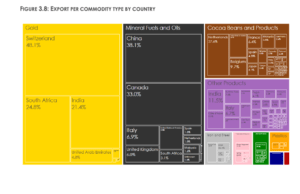The country remains very susceptible to external economic shocks due to its heavy reliance on exporting raw minerals and limited trading partners, says a report by the Ghana Statistical Service (GSS).
Titled the ‘Ghana 2022 Trade Vulnerability Report’, one of its key findings is the stark disparity between exports and imports – with imports exceeding exports by approximately GH₵4.5billion in 2022. Thus, total value of the country’s imports stood at GH₵148.6billion and exports at GH₵144.1billion. This trade imbalance, it highlighted, is a cause for concern.
It also sheds light on the significant risks associated with Ghana’s current trade composition, since the country’s dependence on a handful of commodities and trading partners leaves it vulnerable to global market fluctuations; potentially hindering strengthening of the economy.
The findings underscore an urgent need for economic diversification and a shift toward manufacturing to enhance the nation’s trade resilience.
Speaking at the report’s launch in Accra, Prof. Kobinna Annim, Government Statistician, highlighted the volatility of macroeconomic variables by stating: “The volatility surrounding our [Ghana’s] macroeconomic variables is striking. There isn’t a single variable that consistently follows a steady growth path over a 5- to 7-year period”.

He emphasised the need to enhance trade diversification, aligning this goal with Sustainable Development Goal 17.
The country’s three main export products are gold (37.5 percent), mineral fuels and oils (30.6 percent) and cocoa beans and products (12.4 percent), which constitute over 80 percent of all exports. Mineral fuels and oils account for more than a quarter (26.8 percent) of total imports, followed by machinery and electrical equipment (13.3 percent) and chemical products (10.7 percent).
Prof. Annim pointed out that exports are heavily skewed toward raw materials and minerals, which possess limited market value. He acknowledged the potential of the services, industry and agriculture sectors in driving economic transformation, but noted that the dominant services sector is primarily retail-focused and lacks a high-end presence.
“Utilising data can help us negotiate trade more effectively. Our current trend involves exporting raw materials while importing finished goods; but with data-driven strategies, cost-effective imports become possible,” Prof. Annim added.
He urged the adoption of digitalisation and formation of partnerships as key steps toward achieving a more stable and prosperous economic path.
The country’s trade relations, both exports and imports, are predominantly with Europe, constituting more than a third of all exports (35.9 percent) and imports (39.2 percent). This is followed by Asia with 28.5 percent of all exports and 37.2 percent of imports. The value of imports is higher than the value of exports for all continents except for Africa and North America: exports to other African countries are GH₵13.2billion higher than imports, and the difference is GH₵6.8billion for North America.
Economist and Associate Professor at the Institute of Statistical, Social and Economic Research (ISSER), Charles Godfred Ackah, expressed concerns over Ghana’s low percentage of manufactured or value added exports – emphasising the need for a reevaluation of the country’s industrialisation strategy.
Prof. Ackah highlighted that manufactured exports constitute only 5 percent of Ghana’s total exports, a figure significantly lower than that of leading global economies.
He drew attention to the achievements of countries like South Korea, Malaysia and Sri Lanka, which have managed to achieve much higher percentages in manufactured exports. Prof. Ackah stressed the importance of nurturing domestic industries and enhancing manufacturing capabilities as a means to bolster export potential and overall economic prospects.

The report also sheds light on the geographical distribution of the country’s trade partners. Notably, four countries – Switzerland, China, Canada and South Africa – make up over half of all Ghana’s exports, while six countries – China, the United Kingdom, Netherlands, United States of America, India and Switzerland – contribute over half of all imports. The report underscores the necessity of diversifying both trading partners and export commodities/products to reduce trade vulnerability.
The report established that about half – 50.4 percent – of all Ghana’s exports to Europe go to Switzerland, followed by 13.0 percent to the Netherlands and 8.9 percent to Italy. China (44.3 percent) and India (33.9 percent) together make up more than three-quarters (78.2 percent) of all Ghana’s exports to the Asian continent.
In Africa, 80.6 percent of Ghana’s exports go to four countries: South Africa (51.3 percent) followed by Ghana’s neighbouring countries Burkina Faso (15.7 percent), Côte d’Ivoire (8.2 percent) and Togo (5.4 percent). For North America, 71.4 percent of all exports go to Canada.
In addition to its reliance on limited trading partners, Ghana’s export composition is dominated by a few primary products, including gold, crude petroleum and cocoa. Gold and crude petroleum, in particular, constitute over two-thirds of all exports. The report highlights the need for Ghana to identify new areas of export growth and diversify its exports beyond traditional raw materials.
The call for economic diversification and increased emphasis on manufacturing aligns with broader strategies to reduce vulnerability to external shocks. By adding value to products through manufacturing processes, the economy can create higher-quality goods that appeal to international consumers – potentially leading to increased exports and economic growth.
As the country continues to navigate its trade challenges, the insights provided by the ‘Ghana 2022 Trade Vulnerability Report’ serve as a valuable resource for policymakers and planners. The report highlights the importance of taking strategic measures to enhance trade resilience, foster economic diversification and promote sustainable growth in the economy.










